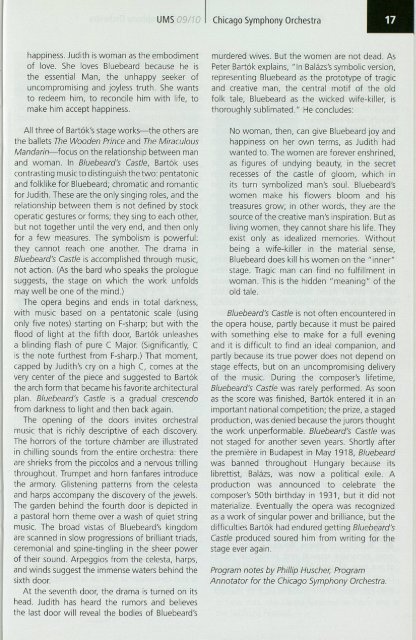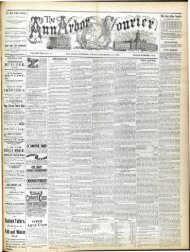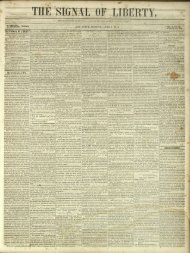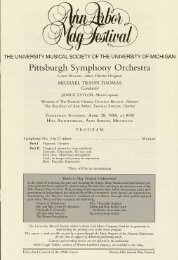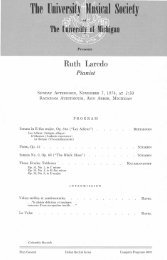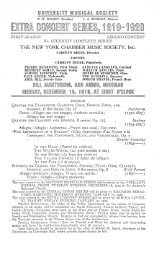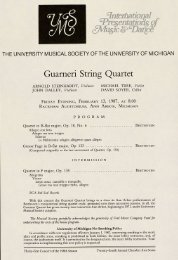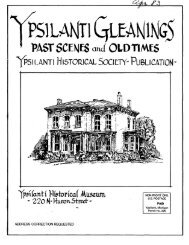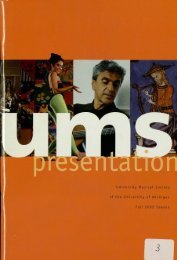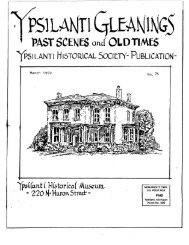Bill T. Jones (Artistic Director/Co-Founder - Ann Arbor District Library
Bill T. Jones (Artistic Director/Co-Founder - Ann Arbor District Library
Bill T. Jones (Artistic Director/Co-Founder - Ann Arbor District Library
Create successful ePaper yourself
Turn your PDF publications into a flip-book with our unique Google optimized e-Paper software.
happiness. Judith is woman as the embodiment<br />
of love. She loves Bluebeard because he is<br />
the essential Man, the unhappy seeker of<br />
uncompromising and joyless truth. She wants<br />
to redeem him, to reconcile him with life, to<br />
make him accept happiness.<br />
All three of Bartok's stage works the others are<br />
the ballets The Wooden Prince and The Miraculous<br />
Mandarin—focus on the relationship between man<br />
and woman. In Bluebeard's Castle, Bartok uses<br />
contrasting music to distinguish the two: pentatonic<br />
and folklike for Bluebeard; chromatic and romantic<br />
for Judith. These are the only singing roles, and the<br />
relationship between them is not defined by stock<br />
operatic gestures or forms; they sing to each other,<br />
but not together until the very end, and then only<br />
for a few measures. The symbolism is powerful:<br />
they cannot reach one another. The drama in<br />
Bluebeard's Castle is accomplished through music,<br />
not action. (As the bard who speaks the prologue<br />
suggests, the stage on which the work unfolds<br />
may well be one of the mind.)<br />
The opera begins and ends in total darkness,<br />
with music based on a pentatonic scale (using<br />
only five notes) starting on F-sharp; but with the<br />
flood of light at the fifth door, Bartok unleashes<br />
a blinding flash of pure C Major. (Significantly, C<br />
is the note furthest from F-sharp.) That moment,<br />
capped by Judith's cry on a high C, comes at the<br />
very center of the piece and suggested to Bartok<br />
the arch form that became his favorite architectural<br />
plan. Bluebeard's Castle is a gradual crescendo<br />
from darkness to light and then back again.<br />
The opening of the doors invites orchestral<br />
music that is richly descriptive of each discovery.<br />
The horrors of the torture chamber are illustrated<br />
in chilling sounds from the entire orchestra: there<br />
are shrieks from the piccolos and a nervous trilling<br />
throughout. Trumpet and horn fanfares introduce<br />
the armory. Glistening patterns from the celesta<br />
and harps accompany the discovery of the jewels.<br />
The garden behind the fourth door is depicted in<br />
a pastoral horn theme over a wash of quiet string<br />
music. The broad vistas of Bluebeard's kingdom<br />
are scanned in slow progressions of brilliant triads,<br />
ceremonial and spine-tingling in the sheer power<br />
of their sound. Arpeggios from the celesta, harps,<br />
and winds suggest the immense waters behind the<br />
sixth door.<br />
At the seventh door, the drama is turned on its<br />
head. Judith has heard the rumors and believes<br />
the last door will reveal the bodies of Bluebeard's<br />
UMS Chicago Symphony Orchestra<br />
murdered wives. But the women are not dead. As<br />
Peter Bartok explains, "In Balazs's symbolic version,<br />
representing Bluebeard as the prototype of tragic<br />
and creative man, the central motif of the old<br />
folk tale, Bluebeard as the wicked wife-killer, is<br />
thoroughly sublimated." He concludes:<br />
No woman, then, can give Bluebeard joy and<br />
happiness on her own terms, as Judith had<br />
wanted to. The women are forever enshrined,<br />
as figures of undying beauty, in the secret<br />
recesses of the castle of gloom, which in<br />
its turn symbolized man's soul. Bluebeard's<br />
women make his flowers bloom and his<br />
treasures grow; in other words, they are the<br />
source of the creative man's inspiration. But as<br />
living women, they cannot share his life. They<br />
exist only as idealized memories. Without<br />
being a wife-killer in the material sense,<br />
Bluebeard does kill his women on the "inner"<br />
stage. Tragic man can find no fulfillment in<br />
woman. This is the hidden "meaning" of the<br />
old tale.<br />
Bluebeard's Castle is not often encountered in<br />
the opera house, partly because it must be paired<br />
with something else to make for a full evening<br />
and it is difficult to find an ideal companion, and<br />
partly because its true power does not depend on<br />
stage effects, but on an uncompromising delivery<br />
of the music. During the composer's lifetime,<br />
Bluebeard's Castle was rarely performed. As soon<br />
as the score was finished, Bartok entered it in an<br />
important national competition; the prize, a staged<br />
production, was denied because the jurors thought<br />
the work unperformable. Bluebeard's Castle was<br />
not staged for another seven years. Shortly after<br />
the premiere in Budapest in May 1918, Bluebeard<br />
was banned throughout Hungary because its<br />
librettist, Balazs, was now a political exile. A<br />
production was announced to celebrate the<br />
composer's 50th birthday in 1931, but it did not<br />
materialize. Eventually the opera was recognized<br />
as a work of singular power and brilliance, but the<br />
difficulties Bartok had endured getting Bluebeard's<br />
Castle produced soured him from writing for the<br />
stage ever again.<br />
Program notes by Phillip Huscher, Program<br />
<strong>Ann</strong>otator for the Chicago Symphony Orchestra.


